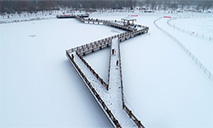Feature: Skiing a rising "social currency" in China
CHANGCHUN, Feb. 10 (Xinhua) -- For the third year in a row, Qu Nan, a 20-year-old girl from Shanghai, has rented a flat in northeast China's Jilin city during her winter vacation, out of her love for skiing.
"Hotels near ski resorts are expensive. So my boyfriend and I chose to stay in the city proper, which costs us just 2,000 yuan (about 314 U.S. dollars) a month," Qu said. "I met a lot of like-minded friends -- including my boyfriend -- through house-sharing and car-sharing."
Despite her lifestyle of careful calculation and strict budgeting, skiing is by no means an "economical" sport. According to Qu, a set of moderately-priced ski gear costs over 10,000 yuan, and a season card of a ski resort is around 5,000 yuan, let alone transportation, accommodation, and dining.
The city's Lake Songhua Resort received a total of 39,200 tourists during the week-long Spring Festival holiday beginning Jan. 31, an increase of 72 percent over last year, said its general director Zhao Lanju.
"The opening of the Beijing Winter Olympics during the Spring Festival has undoubtedly encouraged more people to go skiing, especially among young people. Customers aged between 20 and 40 account for 60 percent at our resort," Zhao said.
Not only young ski-lovers, more and more professional elites and the affluent in China have fallen for the sport, which has increasingly become a trendy lifestyle and daily winter recreation.
As of October 2021, 346 million Chinese participated in ice-and-snow sports, according to the National Bureau of Statistics. China Tourism Academy also expected China's ice-and-snow leisure tourism revenue to reach 323.3 billion yuan in the 2021-2022 season.
On Xiaohongshu, a lifestyle-focused social media platform that is popular among Chinese youngsters, posts with the key word "skiing" in January 2022 increased by 232 percent year on year. The latest posts show that posting locations have expanded from northern China to the whole country.
Online travel service provider Qunar.com said the number of ski resort tickets sold on its platform has doubled during the Spring Festival holiday compared to last year. Mafengwo, a travel service and social networking platform, said articles of "skiing guide" and "snowboarding guide" were viewed three times more during the holiday than the beginning of this winter.
Post-1990s and -2000s have become the main consumer groups of skiing tourism. The online travel agency Tongcheng-eLong said post-1990s and -2000s have accounted for over half of users booking ice-and-snow related tickets. On Alibaba's travel branch Fliggy, bookings for Spring Festival ice-and-snow travel among the post-2000s group increased by more than 80 percent over last year, far outpacing other age groups.
Among the increasing ski-goers in China, more people have developed serious interests in the sports. The number of tourists spending two or more days in a ski resort in 2021 increased by 180 percent compared with 2019, and more than 70 percent of ski-goers have re-purchased skiing products, according to Trip.com Group, a major online travel agency in China.
In the meantime, more and more people have resorted to "crowd-ordering" in pursuit of their common hobby. Qu herself has become an influencer on Xiaohongshu, sharing her experience and tips of skiing in Jilin, and most importantly, gathering people with the same passion to pack up.
"Skiing brings me not only the joy of sports but also the joy of sharing with friends," she said.
Photos
Related Stories
Copyright © 2022 People's Daily Online. All Rights Reserved.










